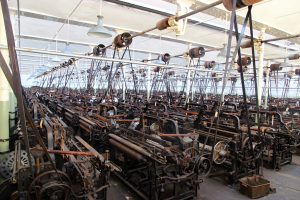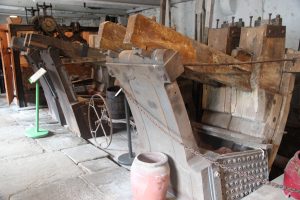Following on from the news in 2016 that Lancashire County Council had taken the decision to close several of its museums, including Queen Street Mill and Helmshore Mills Textile Museum, English Heritage has just announced its decision not to acquire these two sites. For the moment, care and maintenance will continue but the museums will not re-open for the foreseeable future, if at all.
Higher Mill at Helmshore dates from c.1789 when the Turner family constructed a small, stone-built mill to enable local home-based weavers to have their cloth fulled without having to trek all the way across the fells to Rochdale. It possesses one of the very few remaining wooden fulling stocks driven by a water wheel (left. Click on the image for a larger version).
The second mill on the site, Whitaker’s Mill, was a cotton mill which suffered the common fate of fire due to the flammability of cotton dust, but was rebuilt and equipped for condenser spinning which makes use of cotton waste. It was therefore a spinning mill, and so is complementary to Queen Street Mill which is for weaving.
The museum displays tell two stories, the Wool Story and the Cotton Story, and has quite recently been refurbished with an ingenious hub linking the two sites.
 Queen Street Mill, dating from the 1890s, is the only surviving site in the world where the original steam engine is still fired daily and works the original weaving looms in the mill (left. Click on the image for a larger version).
Queen Street Mill, dating from the 1890s, is the only surviving site in the world where the original steam engine is still fired daily and works the original weaving looms in the mill (left. Click on the image for a larger version).
It was run by a community of weaving concerns, not by an entrepreneur seeking a profit, and as such is a very rare example of this cooperative way of the community establishing a new mill for mutual benefit. The site has Grade 1 listing status.
Negotiations for the future will continue but a prolonged shut down with only static care and maintenance would certainly prejudice the resurrection of Queen Street Mill. Ian Gibson, former Curator of Industry and Technology, Museums Service, Lancashire County Council, has pointed out that the boiler flame bed is below mill pond water level and with no fires lit over many months the fire brick will get wet enough to start disintegrating. Given the importance of textiles to the British economy from the medieval period onwards, it is shameful that neither the County Council nor the body concerned with the conservation of historic places which bring the past to life consider these two sites worth saving.
Update February 2023
We note that this post from 2017 has been receiving many hits. We are not entirely sure why this but, in order to bring everyone reading this post up to date Prof. Marilyn Palmer, the original author, writes:
The AIA had worked hard to publicise the value of Queen Street Mill, and had put in an application for the site to be recognised in the 7 Most Endangered programme run by Europa Nostra. This was not successful but did generate considerable publicity. The National Trust, who own Styal Mill, a water-powered cotton mill not far to the south in Cheshire, took an interest and worked with Lancashire County Council to make suggestions for the improvement of the site as a visitor attraction. Subsequently, the mill site was re-opened although with a reduced offer in terms of visiting hours. Its café is open most of the year and attracts considerable visitors who can at least admire the exterior of the site.
Visit https://www.lancashire.gov.uk/leisure-and-culture/museums/queen-street-mill-textile-museum/ to see the opening times this year.


16 Comments
Why can’t it be run with mostly by volunteers as it was when Hanna Benson was the manager? It was the same time as Prince Charles visited and he thought it was part of our heritage.
In ANNA Bensons day there were paid staff, assisted by volunteers. Don’t you think the possibility of running it by volunteers hasn’t already been thought of?
This is shameful and scandalous….this should be a world heritage site equal to the pyramids – this was the biggest part of the industrial revolution – it’s our heritage – school children had been getting a real taste of our history when they visited the sites – it makes you wonder what would have occurred if this would have been a museum in London, would more effort be made to save it then? The old saying goes….’ England’s bread was held by Lancashire’s thread…..the powers that be might need to bear that in mind.
Speaking as a trustee of a museum in London, I very much doubt that something like this would do any better at all in London. This foes deserve to be saved but unfortunately the HLF waste a lot of money on things that will soon be forgotten.
Hi Anne, yes Anna Benson did a great job at Queen Street for Pennine Heritage but the 1980s business plan relied less I think on volunteers than on letting space to other craft businesses, and they did not last long in that location on the edge of town. Pennine Heritage had a number of ideas that were ahead of their time, but was wound up. It is good that the County Council was able to step in and keep it running within its Museum Service for as long as it could, and before austerity bit. Now is the time to pass the baton on to someone else, or a partnership, that recognizes that some revenue funding will always be needed at both of this mills. Is it fair on skilled employees to ask unpaid volunteers to take their place?
The Prince of Wales has kept up his interest in Burnley as can be seen by the welcome presence of the Prince’s Trust in the “Weavers Triangle” in the town.
Everything has a limit – the cost of maintaining such an old building and machinery is beyond practicality. To preserve such a folly as this, only to serve as a reminder of a hard working life is ridiculous. Demolish and rebuild either with housing or commercial property that would be better suited to serve and benefit the community as a whole.
Assign it to the history books asap.
Would be a great pity to loose this part of not only Lancashire’s history but a part of what made Britain Great in the past.
Could a deal not be done with the museum of science and industry in Manchester to do some kind of joint project. Industry in action.
It’s quite an important museum bearing in mind Lancashire used to produce well over 50% of the world woven cotton goods. . A business plan is needed that works on the basis of using the mill to produce cloth that can be finished elsewhere and sold. It’s maybe a business that the National Tust couild help re-invigorate. Location isn’t good for a museum as it’s difficult to find unless you know the area.
See also Mike Nevell’s blog “Stop Obsessing About Stonehenge – the Real Threat is to Lancashire’s World Class Industrial Past” https://archaeologyuos.wordpress.com/
Would the national trust or English heritage not take interest in looking after this amazing piece of our history, we can’t keep letting things be forgotten and disappear, we all know councils are only interested in investing in themselves
I feel so sad we are loosing our heretege I have loved both mills over the years it reminds me of my grandparents and how they lived and worked and remember the stories they told ; I was hoping to teach my grandchildren and show them these magnificent mills in The future . Shame on you councils and government.
This is appalling news. It is incomprehensible to me that this should be allowed to happen. Lancashire’s history with cotton cannot just be consigned to reading about it when working machinery is still available.
To Time expired.
Everything we have today stems from the inventors and their inventions. Prior to the Industrial Revolution which originated largely in the North West there was no large scale industry. Without the inventions in weaving and spinning which came from inventors such as John Kay, James Hargreaves, Samuel Crompton and Richard Arkwright all from the North West who knows where we would be today. So, remembrance of these inventions is important in our recognition of where we are today and how we got here. And, more importantly, how easily things could have been so different. So, the buildings where we are made aware of “how it was” and the machines which were new inventions back in the day are equally as important in reminding us of the often painful transition from cottage industry to Industrialisation. And anyway, apart from all those considerations they are Tourist attractions and of great interest to all those who visit. The social history and stories of personal tragedies such as Loom Rioters who were transported, to name but one “angle” and the terrible social conditions endured by many must surely serve to remind us of our relative “good fortune.” Without these buildings and their machinery it would be impossible to give the correct impression of how bad things were for the ordinary working people.
what about asante kente ,they also inspired industrialisation
Mills were made to make money, mostly by men who quickly forgot the value of manufactures as the cost came down. Now they are conservatives, comfortable in their inheritances but anxious about their ancestry, fearful of the future which filled their forefathers’ pockets. We pinch pennies and peel away the past at our peril, a people in penury pished beyond the pale of the past…